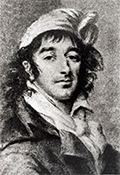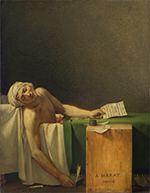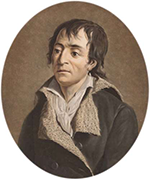Jean-Paul Marat
Jean-Paul Marat was a scientist and journalist most well-known for his writings in support of the more radical elements of the French Revolution. He was born on May 24, 1743, in Boudry, Neuchâtel, Switzerland. He went to France to study and trained as a doctor and practiced both there and in England. He opened his own medical practice in Paris, treating a number of high-profile clients, including Charles Philippe, the youngest brother of King Louis XVI. 
He had talent in other realms of science as well, conducting experiments in electricity and optics. He did not secure recognition from his peers for his achievements (including being denied admission to the Académie des Science and ridiculed by Voltaire) and, embittered, turned to writing instead. He gained much more fame as an author and journalist, first exploring philosophical themes and then embracing political themes first and foremost. His earlier publications included Essay on the Human Soul and A Philosophical Essay on Man. Marat hadn't always been a revolutionary. In early 1789, he had published a pamphlet titled Offrande à la patrie (Offering to Our Country), expressing support for the monarchy. He soon changed his mind, however, for good. One of his famous works was The Chains of Slavery, an uncompromising indictment of despotism. When the French Revolution got underway, Marat took to publishing a journal called L'ami du Peuple (The Friend of the People). Extremely radical in his views of equality, Marat found no solace in the new leaders of France, since he considered them to be nearly as aristocratic as the king and nobles had been beforehand. He called for the members of the Second Estate, the nobles, to be thrown out of the National Constituent Assembly. He called for a true uprising of a most egalitarian nature and embraced the need for a temporary dictatorship in order to remove the impediments to such a vision. He also had no qualms with executions as a means of eliminating those who he considered oppressors. He also frequently targeted people who others would have considered heroes of the Revolution, including Antoine Barnave, Jean Billy, Jacques Necker, and the Marquis de Lafayette.
Marat fled to England for a time in the wake of the Champ de Mars Massacre, when authorities blamed him and his writings for inciting radical Jacobins that resulted in the National Guard's firing on an unarmed crowd in 1791. He returned in 1792 and set about publishing more targeted writings. Marat won election to the National Convention and found like-minded people in Maximilien Robespierre and others of the radical Montagnard faction of the Jacobin Club. He jumped wholeheartedly into the rivalry with the Girondins, another Jacobin faction. Marat issued incendiary attacks on Girondins and others in his journal, which was published irregularly. He found himself the target of verbal attacks in the Convention assemblies and, more than once, the recipient of an arrest decree. He faced trial before the Revolutionary Tribunal in April 1793 but, after a spirited defense, won acquittal on charges of inciting violence. 
The Montagnards gained the upper hand for good on June 2, 1793, when a group of tens of thousands of armed soldiers stormed into the Convention and voiced their support for Robespierre, Marat, and their fellow radicals. Robespierre eventually gained the leadership of the government, and Marat was at the top of his fame. Marat took frequent medicinal baths to ease a chronic skin condition. He was in the midst of one such session on July 13, 1793, when a Girondin sympathizer named Charlotte Corday paid him a visit in his Rue de Cordelier apartment. She stabbed him to death where he sat in his bath.
|
|
Social Studies for Kids
copyright 2002–2025
David White





